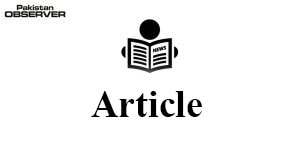World Day against child labour 2021 A child employed is a future destroyed
PAKISTAN has around 87.938 million children approximately 47% of Pakistan’s total population.
Children have special rights and they need their rights to be protected in all respects without any prejudice in any way. This is necessary to ensure their well-being, successful development and their rights.
Not only parents, but all governments and state institutions have duty to create a child-friendly environment and to promote children’s rights in order to ensure our future.
Child labour is characterized as work which is mentally, physically, socially or morally dangerous and harmful to children; and which interferes with their schooling by depriving them of the opportunity to attend school or forcing them to leave school prematurely; or requiring them to attempt to combine school attendance, with excessively long and heavy labour.
Child labour is a grave social problem. It is a practice that engages children in economic activities at the cost of their potential development. Child labour can negatively affect physical, mental, social and emotional health of a child.
Countries and organizations across the global north and south have declared child labour violation of children’s right.
Pakistan is signatory to several international conventions which demand immediate and effective measures to eradicate child labour. These commitments require urgent action on eradication of child labour.
The Constitution of the Islamic Republic of Pakistan 1973 contains provisions pertaining to child labour.
Article 11 provides that “No child below the age of Fourteen years shall be engaged in any factory or mine or any other hazardous employment”.
Article 25-A, stipulates, “The State shall provide free and compulsory education to all children of the age of five to sixteen years in such manner as may be determined by law.”
When Pakistan announced its first case of coronavirus (COVID-19) on February 26, 2020, public at large thought that this virus will affect only elders and people with prior health conditions.
However, after four and half months of complete and smart lockdowns, this perception changed. People quickly realized that children have been the biggest affectees of this situation.
Whether it was loss of education due to closing of schools and lack of internet facilities, or issues in access to healthcare services, or shortage of food supply due to their parents losing their jobs; children have been hit hard by this pandemic.
According to a World Bank report, more than 930,000 Pakistani school going children might drop out because of poverty caused by the COVID-19 pandemic.
It is alarming that Pakistan already has the second largest population of out-of-school children (age 05 to 16) in the world.
According to the report, these children dropping out and entering labor force before graduation would cause Pakistan $67 billion in the gross domestic product (GDP) at net present value in 20 years compared to if they had completed their education and then entered the market.
A situation where parents have no means to provide food and future to their children, they force children to earn for their own needs.
The pandemic has even disturbed the coffers of rich, children are being preferred as maids, factory workers, hawkers, shop helpers as they’re cheap labour and can be dominated more.
According to experts, the financial implications of COVID-19 will also include child marriage and trafficking for commercial and sexual exploitation.
Child labour is socially accepted mainly and has roots into more population and lack of awareness amongst parents about harmful effects of child labour on children, which includes survival, protection, development and wellbeing.
Additionally, employers prefer keeping children because they are easy to be controlled, abused, ordered and exploited on extremely low or no wage.
There are various reasons of child labour in Pakistan. Almost one-third of its population falls below the poverty line as the country ranks number five in the list of countries by population.
The issue of child labour has a circular causal relationship with poverty as one of its root causes is poverty which in turn is caused by it.
Child labour is also closely linked to cultural norms and the failure of Pakistan’s education system to provide high quality education at primary and secondary level.
Around 75% of working children have not completed primary education or are only able to recite the Quran.
Most working children come from families of 10-12 members where one wage-earner may have to feed up to 10 people.
A study of scavenging children found that the average number of siblings of one child was 7.6 with SD + 2.61. This leads to an expectation that children should contribute to family income and a sense that child labour is therefore not unjust.
Parents who believe education to be unhelpful validate their understanding of child labour as being likely to give them a more productive future.
In many cases, especially in cases of bonded-child-labour and girl child servitude, it is not the children but parents, who receive wages directly or indirectly and sometimes in peshgi (advance).No employment contracts are ever issued.
While peshgi bondage began in the agricultural sector it has crept into mining, fishing, brick making and even to domestic servitude.
Contemporary slavery in Pakistan, in most cases, emanates from entrenched and socio-culturally acceptable norms.
Cultural and business elites such as feudal landlords or business owners are often associated with high levels of child labour.
A complex web of culture, traditions, livelihood dynamics and absence of alternatives are interconnected.
Parents’ own education, age, gender, local economy, ecology and cost of schooling all matter. Behind all of this is an inadequate response by the state.
—The writer is Manager Research and Communication, Society for the Protection of the Rights of the Child, SPARC, Islamabad.










